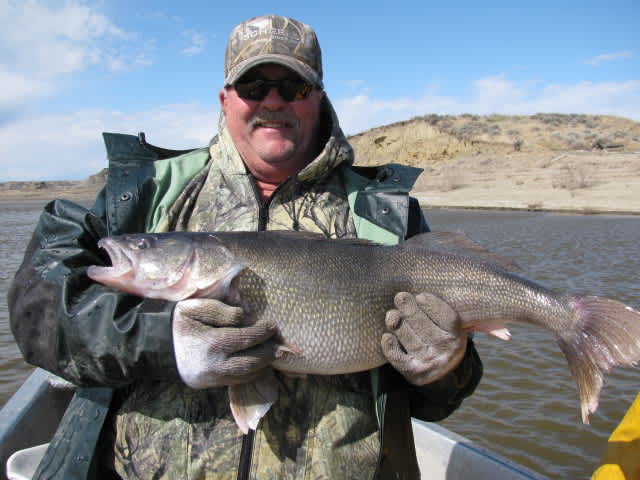2012 Fort Peck Reservoir Walleye Spawning Operation Nets 47 Million Eggs
OutdoorHub 05.31.12

Despite an early ice-out, prolonged cool water temperatures kept this year’s walleye spawning operation on Fort Peck Reservoir capped at 47 million eggs.
While that’s short of the annual goal of 90 million eggs, this year’s count was 7 million eggs higher than last year, said Montana Fish Wildlife & Parks Biologist Heath Headley.
Depending on water levels, temperature, and other factors, walleye spawning success and recruitment to the fishery can be extremely variable. That’s why FWP crews and a large contingent of volunteers capture mature walleyes in nets in the reservoir’s Big Dry Arm every spring, strip their eggs and milt, and transport them to area hatcheries for rearing.
Rising water temperatures trigger the walleyes’ urge to spawn and help “ripen” the fish. But the water this year was slow to warm, which dampened spawning success.
“During the first three weeks after ice-out we collected good numbers of green (not ready to release eggs) female walleye, but only 30 percent of those females ripened up to spawn,” Headley said. “Water surface temperatures in the Big Dry Arm never surpassed 50 degrees until mid-April, which was too late to fully trigger spawning activity.”
However, initial hatching of the walleye eggs, commonly known as “eye-up,” was exceptionally good this year at the Fort Peck and Miles City state hatcheries.
“Typically we see 50 percent eye-up, but this year it is looking like 70 percent, which will give us 20 percent more walleye fry to work with than last year,” Headley said. “This can be largely attributed to increased forage items in the reservoir. Improved forage conditions led to healthy fish, and healthy fish led to good egg production.”
As a result of this year’s egg-collecting and rearing, 17.8 million walleye fry have already been released back into Fort Peck Reservoir. Headley said the remaining fry filled all the rearing ponds at the Fort Peck and Miles City and hatcheries, where they’re being kept until they’re fingerlings. The fingerling walleye will be stocked in coming weeks.
One of the largest walleyes weighed and measured during this year’s spawning operation was a 15.4-pound female. Strong numbers of walleye in the 20-inch to 25-inch range were also observed.
“Along with good walleye production, we’ve really seen some good yellow perch and cisco numbers over the last year,” Headley said.
In fact, yellow perch were the most abundant species captured in FWP’s trap nets during the walleye spawning operation, and their numbers in Fort Peck Reservoir are at near-record highs.
“The miles of flooded salt cedar in the Big Dry Arm have made excellent spawning and rearing habitat for yellow perch, but they also made our netting efforts a lot more difficult,” he said.

